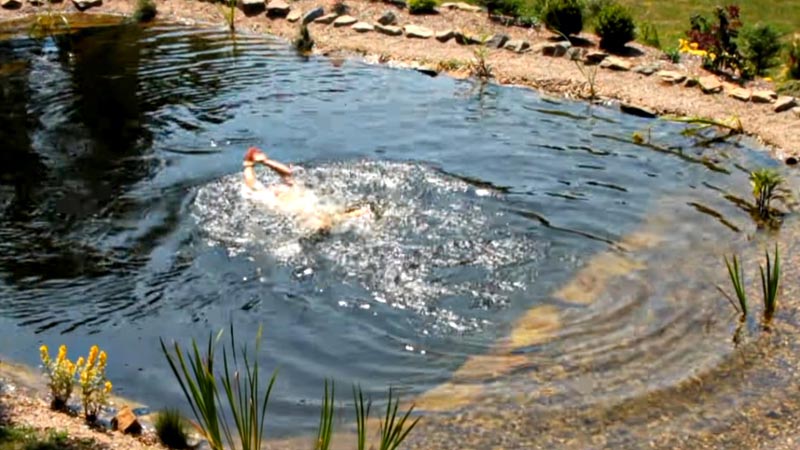Venturing into the allure of pond swimming beckons with the promise of a natural oasis, a departure from the regimented confines of traditional pools.
Yet, beneath the surface lies a nuanced landscape of potential risks. The question lingers: Is it safe to swim in a pond?
Exploring this inquiry unveils a spectrum of considerations—unknown hazards, water quality fluctuations, and the ever-present wildlife factor.
This exploration delves into the complexities of pond safety, offering insights into how to navigate these natural waters while striking a balance between the joys of aquatic recreation and the necessity of informed, cautious engagement with the environment.
Is It Safe to Swim in a Pond?
No, it’s not always safe to swim in a pond. Ponds can pose various risks that swimmers should be aware of before taking a plunge.
Firstly, water quality can be questionable. Unlike treated swimming pools, ponds may contain bacteria, algae, and other microorganisms that can cause infections or skin irritations.
Additionally, ponds can be home to various aquatic plants and creatures that may not be harmful but can still surprise and startle swimmers.
Here are the reasons why swimming in ponds is not safe:
Unknown Hazards
Exploring a pond’s underwater terrain is like entering a hidden realm. While the surface may appear calm, beneath it lies a world of sharp rocks, tangled vegetation, and possibly unwelcome aquatic life.
Swimmers may inadvertently encounter submerged obstacles, leading to injuries or unexpected encounters with less-than-friendly underwater residents.
Water Quality
Unlike meticulously maintained swimming pools, ponds are subject to the whims of nature. Algae blooms, bacteria, and parasites can thrive in the still waters, affecting water quality.
Swimmers risk exposure to irritants and harmful microorganisms that can cause skin infections, digestive issues, or more severe health problems.
Depth and Submerged Objects
Ponds are notorious for their uneven bottoms and hidden surprises. A seemingly gentle entry can quickly transform into a treacherous situation as depths vary unpredictably.
Submerged branches, rocks, or other debris may lurk beneath the surface, creating potential hazards for unsuspecting swimmers.
Limited Visibility
The tranquil surface of a pond can be deceiving. Murky water limits visibility, making it challenging to spot potential dangers below.
This lack of clarity not only increases the risk of accidents but also hampers rescue efforts, as locating someone in distress becomes a daunting task.
Cold Water and Hypothermia
The temperature of pond water can be significantly cooler than that of a regulated swimming pool. Prolonged exposure to cold water can lead to hypothermia, a condition where the body loses heat faster than it can produce it.
Swimmers may underestimate the impact of chilly waters, putting themselves at risk of this potentially life-threatening condition.
Currents and Underwater Currents
While ponds may seem still, subtle currents can lurk beneath the surface. Swimmers may find themselves unexpectedly caught in these currents, leading to disorientation and increased difficulty in reaching safety.
Understanding and respecting the water’s unseen movements are crucial for a safe pond-swimming experience.
Bacteria and Waterborne Diseases
Natural bodies of water, including ponds, can harbor bacteria and parasites that pose health risks to swimmers.
Ingesting or coming into contact with contaminated water can result in waterborne diseases such as giardiasis or cryptosporidiosis. Awareness of the potential for waterborne illnesses is essential for those considering a dip in a pond.
Is It Safe to Swim in a Pond With Algae?
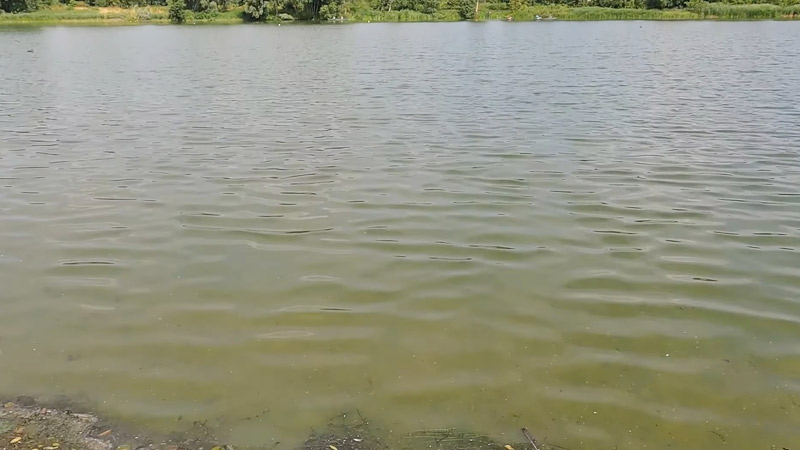
Swimming in a pond with algae can pose significant risks to your health. While not all algae are harmful, certain types can produce toxins that are dangerous to both humans and animals.
Here’s why taking a dip in an algae-infested pond might not be the safest choice:
Algal Blooms
Ponds with excessive nutrients, often from agricultural runoff or warm temperatures, can experience algal blooms.
These rapid increases in algae populations can turn the water into a thick, greenish soup, indicating a potentially hazardous environment.
Toxic Algae
Certain types of algae, such as cyanobacteria, commonly known as blue-green algae, have the potential to produce toxins.
These toxins can cause a range of health issues, including skin rashes, respiratory problems, and gastrointestinal distress. In severe cases, exposure to toxic algae can lead to more serious conditions or even be fatal.
Skin Irritations
Contact with algae in the water can result in skin irritations. The presence of algae may cause itching, redness, or a rash, particularly in individuals with sensitive skin.
Swimmers may not immediately connect these symptoms to the water, making it important to be aware of the pond’s condition.
Respiratory Issues
Inhaling airborne particles from algae or being in close proximity to a pond with a high algal concentration can lead to respiratory problems.
Irritation of the nose, throat, and lungs may occur, especially for individuals with pre-existing respiratory conditions.
Digestive Problems
Swallowing water contaminated with toxic algae can lead to gastrointestinal issues. Symptoms may include nausea, vomiting, stomach cramps, and diarrhea.
The severity of these symptoms can vary depending on the level of exposure and the specific toxins present.
Harm to Pets
If you’re considering taking your furry friend for a swim, be cautious. Dogs, in particular, are susceptible to the effects of toxic algae.
Ingesting contaminated water or licking algae from their fur can result in severe illness or, in extreme cases, death.
Variable Risk Levels
The risk associated with algae in ponds can vary, as not all algae produce toxins. However, it’s challenging to visually identify harmful algae, and water testing is often required for accurate assessment.
Without proper testing, assuming the safety of swimming in an algal-infested pond is a gamble.
Is It Safe to Swim in Farm Ponds?

Swimming in farm ponds can be tempting, offering a picturesque and secluded escape.
However, there are important considerations that make it necessary to approach this activity with caution:
Agricultural Runoff
Farm ponds are often situated in rural areas surrounded by agricultural land. Runoff from farms can introduce various contaminants into the pond, including fertilizers, pesticides, and animal waste. These pollutants can compromise water quality and pose health risks to swimmers.
Bacteria and Pathogens
Animal waste from nearby farms may contain harmful bacteria and pathogens. If this waste makes its way into the pond, it can lead to waterborne illnesses for those who swim in it.
Gastrointestinal issues and skin infections are common concerns when exposed to contaminated water.
Chemical Residues
The use of pesticides and fertilizers in farming can result in chemical residues entering the pond. Swimming in water with elevated levels of these substances can cause skin irritations and may have more severe health implications over prolonged exposure.
Uneven Terrain and Hidden Hazards
Farm ponds may have uneven bottoms and hidden hazards such as rocks, debris, or submerged structures.
This uneven terrain can increase the risk of accidents, injuries, or even drowning, especially if swimmers are not familiar with the pond’s layout.
Limited Oversight
Unlike public swimming areas or regulated pools, farm ponds typically lack the oversight and regular testing that ensure water quality and safety.
The absence of monitoring increases the uncertainty regarding potential risks associated with swimming in these ponds.
Livestock Interaction
In some cases, farm ponds are used for livestock watering. The presence of animals in or around the pond can introduce additional contaminants and increase the risk of waterborne diseases.
Livestock may also contribute to the pond’s turbidity, reducing visibility and potentially concealing hazards.
Can You Swim in a spring-fed pond?

Swimming in a spring-fed pond can be a delightful experience, often characterized by crystal-clear waters and a natural, pristine environment.
However, while spring-fed ponds generally offer cleaner and cooler water compared to other types of ponds, there are still considerations to keep in mind:
Water Clarity
Spring-fed ponds are known for their clarity, thanks to the constant flow of fresh water from underground springs.
The absence of stagnant water reduces the likelihood of algae blooms and enhances visibility, making it easier to spot potential hazards beneath the surface.
Consistent Temperature
Spring-fed ponds tend to maintain a relatively constant temperature, providing a refreshing and enjoyable swimming environment.
The cool, clear water can be especially appealing during hot weather, offering a natural oasis for swimmers seeking a break from the heat.
Natural Filtration
The continuous flow of water from underground springs acts as a natural filtration system, helping to maintain water quality.
This can reduce the presence of contaminants and pollutants, enhancing the overall safety of swimming in a spring-fed pond.
Biodiversity
Spring-fed ponds often support a diverse ecosystem, with clear water allowing for the presence of various aquatic plants and wildlife.
While this biodiversity can contribute to the pond’s natural beauty, swimmers should be aware of their surroundings and respect the delicate balance of the ecosystem.
Depth and Terrain
As with any body of water, it’s essential to be aware of the pond’s depth and terrain. Spring-fed ponds may have uneven bottoms, submerged rocks, or other hidden features.
Taking precautions and understanding the pond’s layout can help prevent accidents and injuries.
Potential Contaminants
While spring-fed ponds generally have cleaner water, it’s still advisable to exercise caution. Runoff from nearby areas, animal activity, or human influence can introduce contaminants.
Regular monitoring and, if possible, water testing can provide insights into the pond’s overall safety.
Waterborne Pathogens
Even in spring-fed ponds, there is a possibility of waterborne pathogens. While the risk may be lower compared to stagnant water bodies, swimmers should avoid swallowing the water and ensure that any open wounds are properly covered to reduce the risk of infection.
Dangers of Swimming in a Pond
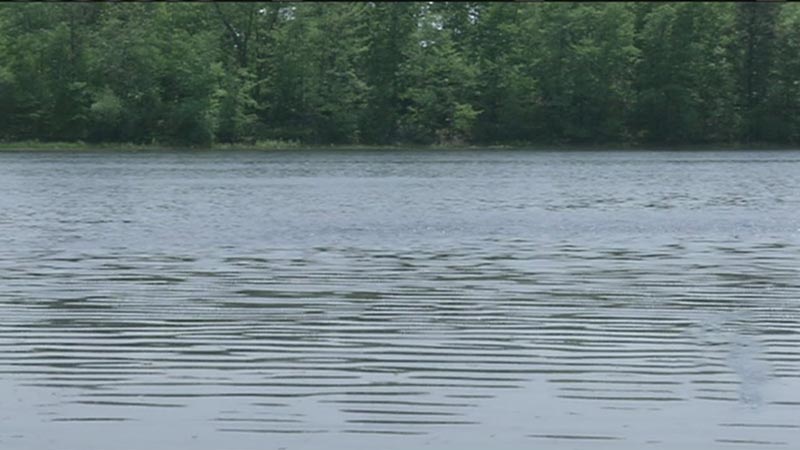
Swimming in a pond can be an adventurous and natural experience, but it’s important to be aware of potential dangers that come with it.
Here are some factors to consider:
Unknown Hazards
Ponds are often home to a variety of hidden dangers beneath the water’s surface. Sharp rocks, submerged branches, and uneven terrain can pose risks to swimmers, leading to injuries or accidents.
Water Quality
Unlike regulated swimming pools, ponds may lack proper water treatment and maintenance.
Water quality can be affected by algae blooms, bacteria, and other contaminants, potentially causing skin irritations, infections, or more serious health issues.
Limited Visibility
Murky water in ponds reduces visibility, making it challenging to see potential hazards. Swimmers may inadvertently come into contact with underwater obstacles, increasing the risk of injury.
Cold Water and Hypothermia
Pond water is often cooler than swimming pools, especially in natural settings. Prolonged exposure to cold water can lead to hypothermia, a condition where the body loses heat faster than it can generate it, posing serious health risks.
Currents and Underwater Currents
Ponds can have hidden currents, even if the surface appears calm. Swimmers may find themselves caught in unexpected currents, leading to disorientation and making it difficult to reach safety.
Waterborne Diseases
Ponds can harbor bacteria, parasites, and other microorganisms that may cause waterborne diseases. Ingesting or coming into contact with contaminated water can result in illnesses such as giardiasis or cryptosporidiosis.
Wildlife Encounters
Ponds are natural habitats for various wildlife, including potentially harmful creatures. Snakes, insects, or aggressive waterfowl can pose risks to swimmers, especially in unfamiliar environments.
Variable Depths
Ponds often have variable depths, and swimmers may encounter sudden drops or deep areas without warning. This can catch individuals off guard, leading to accidents or drowning.
Lack of Lifeguards
Unlike public swimming pools, ponds typically lack lifeguards or emergency personnel on duty. Swimmers must take responsibility for their own safety and be aware of their surroundings.
Limited Rescue Options
In case of an emergency, rescuing someone from a pond can be challenging. Limited visibility, unknown depths, and the absence of proper equipment can hinder rescue efforts.
Can You Make a Pond Safe for Swimming?
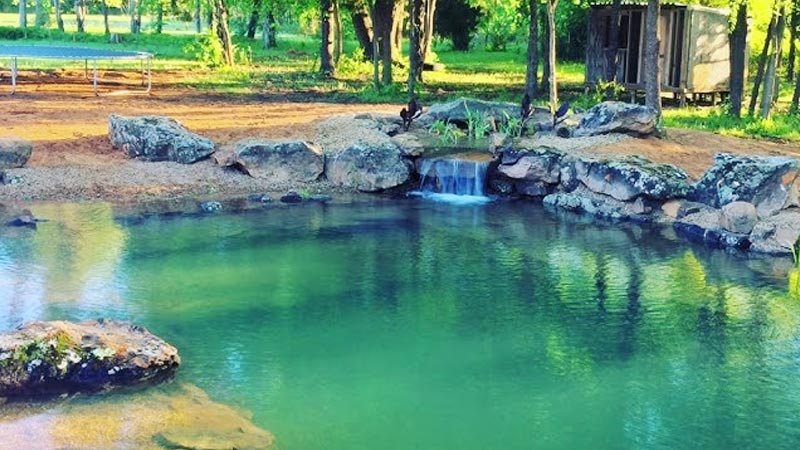
Yes, you can make a pond safe for swimming by implementing various measures to address potential hazards.
Here’s how:
Water Testing
Conduct regular water testing to assess the pond’s quality. Test for contaminants, bacteria, and other potential risks. Knowing the water composition helps identify and address specific issues.
Algae Control
Implement measures to control algae growth, such as adding beneficial bacteria or using environmentally friendly algaecides. This helps maintain water clarity and reduces the risk of harmful algal blooms.
Depth Markers
Install depth markers to indicate different depths within the pond. This provides swimmers with information about the underwater terrain and helps prevent accidents in areas with sudden drops.
Remove Underwater Hazards
Clear the pond of submerged hazards like rocks, branches, or debris. Regularly inspect and remove any obstacles that could pose a risk to swimmers.
Water Circulation
Improve water circulation by adding aeration systems or pumps. Proper circulation helps prevent stagnation, enhances oxygen levels, and reduces the likelihood of waterborne diseases.
Emergency Equipment
Place emergency equipment, such as lifebuoys or first aid kits, in easily accessible locations around the pond. Ensure that these items are in good condition and readily available in case of an emergency.
Shoreline Safety
Address safety concerns along the pond’s shoreline. Install barriers or warning signs to prevent accidental slips or falls. Properly mark swimming areas to guide swimmers away from potential hazards.
Education and Awareness
Educate pond users about potential risks and safety guidelines. Make information available about the pond’s water quality, potential hazards, and emergency procedures.
Wildlife Management
Implement measures to manage wildlife around the pond. Control populations of potentially harmful creatures and create a habitat that minimizes encounters between swimmers and wildlife.
Regular Maintenance
Schedule routine maintenance to address any issues promptly. Regularly inspect and maintain equipment, clear debris, and monitor the pond’s overall condition to ensure a safe and enjoyable swimming environment.
Designated Swimming Areas
Establish designated swimming areas within the pond. This helps concentrate swimmers in safer zones and minimizes the risk of encountering hazards present in other parts of the pond.
How to Test Pond Water for Swimming
Testing pond water for swimming is a crucial step to ensure the safety and well-being of individuals enjoying the water.
Here’s a guide on how to test pond water:
Water Testing Kits
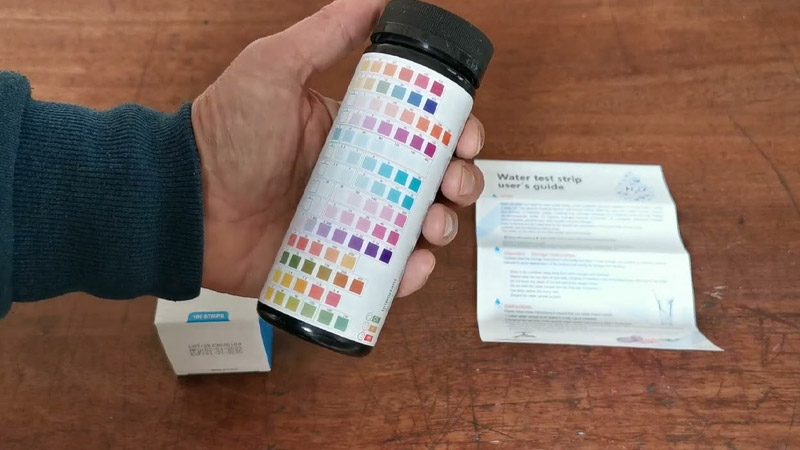
Purchase a water testing kit specifically designed for recreational water testing. These kits are available at pool supply stores, online retailers, or from environmental testing agencies. Ensure that the kit tests for parameters relevant to swimming safety.
PH Levels
Check the pH levels of the pond water. The ideal pH for swimming is typically between 7.2 and 7.8. pH levels outside this range can lead to skin and eye irritation.
Chlorine Levels
While natural bodies of water don’t contain chlorine like swimming pools, you should check for the presence of chlorine byproducts.
Elevated levels of chloramine or other chlorine-related compounds can indicate contamination and may pose health risks.
Bacteria and Pathogens
Use test strips or kits to check for the presence of harmful bacteria and pathogens. Look for indicators of coliform bacteria, which can cause waterborne illnesses. High bacteria levels may suggest contamination from animal waste or human activities.
Algae and Cyanobacteria
Test for the presence of algae and cyanobacteria, especially if the water appears green or murky. Some algae species, such as blue-green algae (cyanobacteria), can produce toxins harmful to humans. Testing for specific algae types can help identify potential risks.
Temperature
While not a traditional water quality parameter, monitoring water temperature is essential. Ensure that the water temperature is suitable for swimming to prevent issues like hypothermia, especially in colder climates.
Total Dissolved Solids (TDS)
Test for TDS, which measures the concentration of dissolved substances in the water. High TDS levels may indicate the presence of contaminants and affect water quality.
Nitrate and Phosphate Levels
Test for nitrate and phosphate levels, as high concentrations of these nutrients can lead to excessive algae growth. Algae blooms can reduce water clarity and potentially produce toxins.
Turbidity
Evaluate water turbidity, which measures the clarity of the water. High turbidity may indicate suspended particles or pollutants and can affect water quality.
Conduct Regular Tests
Perform regular water tests, especially after heavy rainfall, changes in weather, or noticeable changes in water quality. Regular monitoring helps detect issues early and allows for timely corrective actions.
Professional Testing
Consider hiring a professional environmental testing service for a comprehensive analysis. Professionals can provide accurate and detailed results, offering insights into water quality parameters that may not be covered by standard testing kits.
Interpret Results
After conducting tests, carefully interpret the results based on recommended guidelines for swimming water quality.
Compare the results to established standards and guidelines to determine if the pond water is safe for swimming.
FAQS
Can swimming in a pond lead to ear infections?
Yes, swimming in ponds may increase the risk of ear infections. Waterborne bacteria and pathogens can enter the ears, leading to infections if precautions such as earplugs are not taken.
Are there specific seasons when it’s safer to swim in a pond?
Generally, late spring to early fall is considered safer for pond swimming.
Warmer temperatures reduce the risk of hypothermia, and stagnant water conditions in winter may lead to poorer water quality.
How can I protect myself from aquatic plants while swimming in a pond?
Wear appropriate swim gear, such as a rash guard or wetsuit, to minimize direct contact with aquatic plants. Inspect the swimming area and avoid dense vegetation to reduce the risk of skin irritation.
Are there any potential respiratory risks associated with pond swimming?
Yes, inhaling airborne particles from algae or other contaminants in pond water can lead to respiratory issues. Swimmers, especially those with pre-existing respiratory conditions, should be cautious in such environments.
Can swimming in a pond affect my immune system?
Prolonged exposure to waterborne contaminants in ponds may potentially impact the immune system.
While the risk is generally low, individuals with compromised immune systems should take extra precautions or consult with a healthcare professional before swimming in ponds.
To Recap
While swimming in a pond offers a natural and serene experience, safety should be a paramount consideration.
Unseen hazards, variable water quality, and potential wildlife encounters underscore the importance of informed decision-making.
Regular water testing, awareness of surroundings, and adherence to safety guidelines can mitigate risks.
Enjoying a pond swim becomes a balanced pursuit when coupled with precautionary measures, understanding the environment, and respecting the delicate balance of nature.
Ultimately, a thoughtful approach ensures that the refreshing allure of pond swimming harmonizes with a commitment to personal well-being and environmental stewardship.

